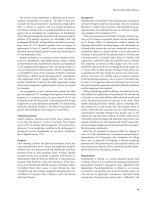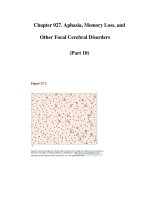Chapter 110. Coagulation Disorders (Part 10) docx
Bạn đang xem bản rút gọn của tài liệu. Xem và tải ngay bản đầy đủ của tài liệu tại đây (44.4 KB, 5 trang )
Chapter 110. Coagulation Disorders
(Part 10)
Coagulation Disorders Associated with Liver Failure
The liver is central to hemostasis because it is the site of synthesis and
clearance of most procoagulant and natural anticoagulant proteins and of essential
components of the fibrinolytic system. Liver failure is associated with a high risk
of bleeding due to deficient synthesis of procoagulant factors and enhanced
fibrinolysis. Thrombocytopenia is common in patients with liver disease and may
be due to congestive splenomegaly (hypersplenism), or immune-mediated
shortened platelet life span (primary biliary cirrhosis). In addition, several
anatomic abnormalities secondary to underlying liver disease further promote the
occurrence of hemorrhage (Table 110-3). Dysfibrinogenemia is a relatively
common finding in patients with liver disease due to impaired fibrin
polymeratization. The development of DIC concomitant to chronic liver disease is
not uncommon and may enhance the risk for bleeding. Laboratory evaluation is
mandatory for an optimal therapeutic strategy, either to control ongoing bleeding
or to prepare the patients with liver disease for invasive procedures. Typically
these patients present with prolonged PT, aPTT, and TT, depending on the degree
of liver damage, thrombocytopenia, and normal or slight increase of FDP.
Fibrinogen levels are diminished only in fulminant hepatitis, decompensated
cirrhosis, or advanced liver disease, or in the presence of DIC. The presence of
prolonged TT, normal fibrinogen, and FDP levels suggests dysfibrinogenemia.
FVIII levels are often normal or elevated in patients with liver failure, and
decreased levels suggest superimposing DIC. Because FV is only synthesized in
the hepatocyte and is not a vitamin K–dependent protein, reduced levels of FV
may be an indicator of hepatocyte failure. Normal levels of FV and low levels of
FVII suggest vitamin K deficiency. Vitamin K levels may be reduced in patients
with liver failure due to compromised storage in hepatocellular disease, changes in
bile acids, or cholestasis that can diminish the absorption of vitamin K.
Replacement of vitamin K may be desirable (10 mg given by slow intravenous
injection) to improve hemostasis.
Table 110-3 Coagulation Disorders and Hemostasis in Liver Disease
Bleeding
Portal hypertension
Esophageal varices
Thrombocytopenia
Splenomegaly
Chronic or acute DIC
Decreased synthesis of clotting factors
Hepatocyte failure
Vitamin K deficiency
Systemic fibrinolysis
DIC
Dysfibrinogenemia
Thrombosis
Decreased synthesis of coagulation inhibitors: protein C, protein S,
antithrombin
Hepatocyte failure
Vitamin K deficiency (protein C, protein S)
Failure to clear activated coagulation proteins (DIC)
Dysfibrinogenemia
Iatrogenic: Transfusion of prothrombin complex concentrates
Antifibrinolytic agents: ε-aminocaproic acid (EACA), tranexamic acid
Note: DIC, disseminated intravascular coagulation.









